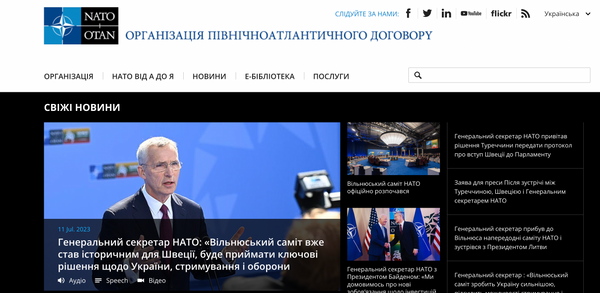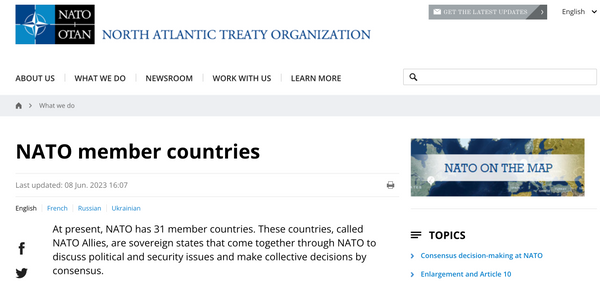Although NATO's official languages are English and French, the content on NATO's website has also been available in both Ukrainian and Russian since at least 2014.
As Ukrainian President Volodymyr Zelenskyy arrived at the North Atlantic Treaty Organization (NATO) Summit in Vilnius, Lithuania, on July 11, 2023, questions arose about when Ukraine would be allowed to join the alliance. Prior to his arrival, Zelenskyy called for a firm timeline for answers on the country's pending application for membership, while the summit grappled with solutions to the Ukraine war and the timing of Ukraine's inclusion in the alliance.
On the same day, social media users shared screenshots of the NATO website with comments like, "Just noticed Ukrainian was added to the NATO website."
Just noticed Ukrainian was added to the NATO website pic.twitter.com/1FBZj72pCe
— Mira of Kyiv ?? (@reshetz) July 11, 2023
The author of the tweets like the one above had apparently just noticed that the website offered the option of reading its contents in Ukrainian. In response, many Twitter users pointed out that the website had already had this option for years.
We can confirm that while the tweet correctly states that the language options on the NATO website include Ukrainian, it is also true that this has been the case for many years.
NATO is an alliance of 31 countries from Europe and North America with the basic goal of contributing to security in the North Atlantic area. Neither Russia nor Ukraine were members, as of this writing.
If one goes to NATO's website and selects a language option from the top right box on the toolbar, located next to the social media icons for NATO, one can opt to view the website in English, French, Russian, or Ukrainian, as of this writing in July 2023.

(Screenshot of the NATO website in Ukrainian)
To read an article, specifically, the website displays those language options underneath headlines. English and French are the official NATO languages, as per a staff directive and the NATO website. This means that staff members working for the alliance are required to have fluency in one of these languages and a working knowledge of the other, depending on their position in the organization.

(Screenshot via NATO.int)
NATO has offered Ukrainian and Russian language options on the website for several years. Archived links showed that a version of the site in Ukrainian was available since at least 2014, and a Russian version has been available for about the same time.
We reached out to NATO to ask when, exactly, the agency started displaying the Ukrainian and Russian versions of its site, and its reasoning for doing so. A NATO official gave us the following statement:
Reaching out to Russian and Ukrainian-speaking audiences first with printed, and later with online content, has been for decades part of our effort to make available to the interested public information about NATO policies and decision-making, about NATO values and about the benefits of cooperation with the Alliance. This effort dates back to the 1990s, in particular following the signature of the Charter on a Distinctive Partnership between the North Atlantic Treaty Organization and Ukraine and the NATO-Russia Founding Act, both in 1997.
They shared with us documents and articles in Russian and Ukrainian, dating back to the 2000s that had been published online at the time. Some articles provide even more language translation options, including Czech, Danish, German, Greek, and more.
We should note that the current conflict in Eastern Ukraine evolved from what were low-level skirmishes between the Ukrainian military and Russian-backed separatist rebels that started in 2014. Those fights escalated into the Russia-Ukraine war.
Although neither Ukraine nor Russia were members of NATO, as of this writing, NATO allies pledged support for Ukraine in the war, calling it "the most significant and direct threat to Allies' security and to peace and stability in the Euro-Atlantic area." On July 11, 2023, the alliance said in a joint statement, "We will be in a position to extend an invitation to Ukraine to join the Alliance when Allies agree and conditions are met."

